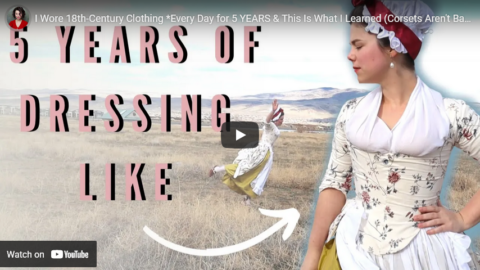Bernadette Banner
Published 26 Oct 2019Ft. my attempts to re-draw them But Better.
[The auction is now concluded.]FOOTNOTES
1. “A literal armful of skirt”: Portrait of Giovanni(?) Arnolfini and his Wife by Jan van Eyck, 1434 http://bit.ly/33ZToHd
2. 16th century split front skirts and square neckline, for comparison: “Portrait of Katherine Parr”, c. 1545 http://bit.ly/2BSUCs5
3. Examples of gowns cut in long panels: from Le Livre des faiz monseigneur saint Loys, composé à la requête du cardinal de Bourbon et de la duchesse de Bourbonnois (p. 195), 1401 – 1500 http://bit.ly/2WcpWLu
4. Exceedingly Extra sleeves: “Saint George Slaying the Dragon” by Jost Haller, c. 1450. Unterlinden Museum. Digital image from Wikimedia Commons. http://bit.ly/2JksLFe
5. Hoods: Le Livre des faiz monseigneur saint Loys, composé à la requête du cardinal de Bourbon et de la duchesse de Bourbonnois (p. 205), 1401 – 1500 http://bit.ly/33Ya7e6
6. Cap? Fillet? from Le Livre des faiz monseigneur saint Loys, composé à la requête du cardinal de Bourbon et de la duchesse de Bourbonnois (p. 211), 1401 – 1500 http://bit.ly/33ZI0Lx
7. French farthingale: “Ballet des fées des forêts de Saint-Germain – Entrée des Esperculates” Daneil Rabel, 1626 http://bit.ly/31M3dal
8. Queen Elizabeth I effigy bodies: “Corset from Elizabeth I’s wax effigy 1603” http://bit.ly/369ezJ5
9. “The Merchant Taylors”, 1749. The British Museum http://bit.ly/2JiYR42
(more…)
October 27, 2022
500 Years of Correcting “Historical” Halloween Costumes
October 5, 2022
Are the protests in Iran about to tip over into actual revolution?
In The Line, Kaveh Shahrooz reports on the still-ongoing public protests after the death of a young woman at the hands of the morality police:

Aftermath of anti-government protests in Bojnord, North Khorasan Province, Iran, 22 September, 2022.
Photo from Tasnim News Agency Bojnord Desk via Wikimedia Commons.
Revolutions are funny things. They sometimes appear impossible until, in one single moment, they become inevitable. In Iran, that moment came on September 13th with the murder of a young woman.
Mahsa Amini, a 22-year-old who was also known by her Kurdish name “Gina”, had come from Iran’s Kurdistan region to visit her brother in Tehran. It was during that trip that she faced a particular humiliation that has become a fact of life for tens of millions of women in that country: a run-in with the country’s gasht-e ershad (“Guidance Patrol”). The role of this roving gang, seemingly imported from Atwood’s Gilead and called Iran’s “morality police”, is to monitor the streets to find and punish violations of the regime’s seventh-century moral and dress codes.
Having determined that Mahsa’s hijab exposed a little too much hair — a few strands of a woman’s hair and men will simply be incapable of controlling their sexual urges, the logic goes — they detained and beat her severely. The story for most women who deal with the morality police typically ends there, after which they are released to seethe at having endured another round of state-imposed gender apartheid. For Mahsa, the story ended differently: with a skull fracture that caused her to be brought, brain dead, to a local clinic. She died there on September 16th.
The murder of Mahsa Amini was the spark that set off a revolution. The killing reminded women of their daily misery at the hands of a regime that, both de facto and de jure, treats them as second-class citizens. And it reminded everyone of the million other senseless cruelties, large and small, that they must endure daily at the hands of a barbaric theocracy. Outraged by the death of an innocent young woman, the people took to the streets in protests that continue to this day.
There have been mass protests in Iran before. In 2009, in response to a widespread belief that Mahmoud Ahmadinejad had illegally stolen the presidential election — to the extent the word “election” means anything in a country where candidates must first be approved by a clerical body loyal to the regime — citizens protested by the millions. Their slogan, “Where’s my vote?” rested on the premise that a fair, albeit controlled, election was something that could change the system for the better. The protesters typically avoided confrontation with security forces. Even when they happened to corner a regime thug periodically, they ensured that no harm was done to him.
September 20, 2022
QotD: Why purple was such a rare colour in the flags of the pre-industrial era
Today, we are used to the effectively infinite range of colors offered by synthetic dyes, but for pre-modern dye-workers, they were largely restricted to colors that could be produced from locally available or imported dyestuffs. If you wanted a given color of fabric, you needed to be able to find something in the natural world which, when broken down could give you a chemical pigment that you could transfer to your fabric in a durable way. That put real limits on the colors which could be dyed and the availability of those colors. Some colors simply couldn’t be produced this way – a good example were golden or metallic colors. If something in a dress was to be truly golden (and not merely yellow), the only way to do that prior to synthetic dyes and paints was to use actual gold, weaving small strands of ultra-thin gold wire into the cloth or embroidering designs with it. Needless to say, that was something only done by the very wealthy. Alternately, if the dye for a given hue or color came from something rare or foreign or difficult to process (for instance, in all three cases, Tyrian or royal purple, which came from the murex sea snails – if you have ever wondered why no country has purple as a national color this is why, before synthetic dyes, coloring your flags and uniforms purple would have been bonkers expensive), then it was going to be expensive and rare and there just wasn’t much you could do about that.
Bret Devereaux, “Collections: Clothing, How Did They Make It? Part IVa: Dyed in the Wool”, A Collection of Unmitigated Pedantry, 2021-04-02.
June 11, 2022
QotD: Modern disposable clothing
Rich Americans – or even middle-class Americans – excel at throwing things away, and the richer we become, the bigger the mounds of cast-off clothing swell. The Salvation Army at one time tried to sell all of the clothing in its stores or to give it away, but the supply now so far outstrips domestic demand that only a fraction of the clothing collected by the Salvation Army stays in the United States. There are nowhere near enough poor people in America to absorb the mountains of castoffs, even if they were given away.
Pietra Rivoli, The Travels of a T-Shirt in the Global Economy, 2015.
June 7, 2022
QotD: Mens’ fashion in Europe versus the USA
Men in Europe really like tight clothes. They really like suit jackets that are what Americas would see as a size too small. Even the portly guys have tight jackets and pants. The difference between Americans and Europeans is that the worst sin for a Euro is to be seen as boring, while the worst sin for an American is to be a phony. This shows up in men’s styles. European men look like they spent hours getting ready to go out, while American men want to look like they live in a house with no mirrors or hot water …
The Z Man, “Travelogue: Talinn”, The Z Blog, 2019-04-03.
March 31, 2022
How Did They Pee in Those Dresses? A Superficial History of Underwear
Bernadette Banner
Published 28 Nov 2020*[2:19] In the English-written sources I’ve found so far. Unfortunately I can’t presently speak for primary accounts written in other languages.
FURTHER READING:
Portraits of ladies not wearing underwear but that I couldn’t include in the video for Proprietary Reasons, lol
Mid-18th century: https://commons.wikimedia.org/wiki/Fi…
Mid-18th c, “La Jupe Relevée” Francois Boucher https://p6.storage.canalblog.com/68/0…
Full analysis of the 15th century Lengberg Castle finds: https://www.academia.edu/27335143/The…
Extra special thanks to Izabela at Prior Attire for permission to use her demonstration video! She has also just put out a video discussing how Victorians dealt with needing to pee: https://www.youtube.com/watch?v=ED-wK…
Abby Cox on 18th Century periods: https://www.youtube.com/watch?v=iV2Tg…
Karolina Żebrowska on Victorian periods: https://www.youtube.com/watch?v=2d_QP…Footnotes and image credits can be found at: http://www.bernadettebanner.co.uk/how…
Want to get started with hand sewing?
Check out my Skillshare original course, “Hand Sewing Basics: Working Wonders with Fabric, Needle & Thread”. To sign up for a free trial and take the class, visit https://skl.sh/bernadettebanner1
This channel is made possible through the generous support of Patreon members. To become a patron, visit https://www.patreon.com/bernadettebanner (although videos will remain free for you here regardless).
Beyond YouTube:
IG @bernadettebanner http://www.instagram.com/bernadetteba…
Management contact for business enquiries:
bernadette@helmtalentgroup.com
March 30, 2022
Combat Boots Save Lives – WW2 Special
World War Two
Published 29 Mar 2022Boots on the ground! Despite all the mobility provided by tanks, trucks and planes, the infantryman had to rely on his own two feet above all else. To march, run and fight, soldiers needed sturdy and comfortable footwear. Choosing between ankle-boots, service-shoes and jackboots, the warring nations were looking for the perfect combat-boot for their soldiers.
(more…)
January 31, 2022
QotD: Weird attempts to violate the Efficient Markets Hypothesis
There’s a lot more to this book, but it all seems to be pointing at the same central, hard-to-describe idea. Something like “All progress comes from violations of the efficient market hypothesis, so you had better believe these are possible, and you had better get good at finding them.”
The book begins and ends with a celebration of contrarianism. Contrarians are the only people who will ever be able to violate the EMH. Not every weird thing nobody else is doing will earn you a billion dollars, but every billion-dollar plan has to involve a weird thing nobody else is doing.
Unfortunately, “attempt to find violations of the EMH” is not a weird thing nobody else is doing. Half of Silicon Valley has read Zero To One by now. Weirdness is anti-inductive. If everyone else knows weirdness wins, good luck being weirder than everyone else.
Thiel describes how his venture capital firm would auto-reject anyone who came in wearing a suit. He explains this was a cultural indicator: MBAs wear suits, techies dress casually, and the best tech companies are built by techies coming out of tech culture. This all seems reasonable enough.
But I have heard other people take this strategy too far. They say suit-wearers are boring conformist people who think they have to look good; T-shirt-wearers are bold contrarians who expect to be judged by their ideas alone. Obviously this doesn’t work. Obviously as soon as this gets out – and it must have gotten out, I’ve never been within a mile of the tech industry and even I know it – every conformist putting image over substance starts wearing a t-shirt and jeans.
When everybody is already trying to be weird, who wins?
Part of the answer is must be that being weird is a skill like any other skill. Or rather, it’s very easy to go to an interview with Peter Thiel wearing a clown suit, and it will certainly make you stand out. But will it be “contrarian”? Or will it just be random? Anyone can conceive of the idea of wearing a clown suit; it doesn’t demonstrate anything out of the ordinary except perhaps unusual courage. The real difficulty is to be interestingly contrarian and, if possible, correct.
(I wrote that paragraph, and then I remembered that I know one person high up in Peter Thiel’s organization, and he dresses like a pirate during random non-pirate-related social situations. I always assumed he didn’t do this in front of Peter Thiel, but I just realized I have no evidence for that. If this advice lands you a job at Thiel Capital, please remember me after you’ve made your first million.)
Scott Alexander, “Book Review: Zero to One”, Slate Star Codex, 2019-01-31.
November 27, 2021
QotD: The zombie that used to be Abercrombie & Fitch
Back when Abercrombie & Fitch was the NYC outfiter for affluent sportsmen, it carried high end guns and fishing tackle and outdoor equipment. Its Madison Avenue store had a shooting range and a casting pool on the roof. Griffin & Howe custom rifles, London best shotguns, and Payne fly rods were waiting there for sale. Alas! the real Abercrombie & Fitch died in the mid-1970s.
The name changed hands repeatedly and was revived in the late 1990s as a completely different kind of entity. The new revival markets sissy fashions to metrosexuals. It’s rather as if after Papa Hemingway shot himself, his name was sold repeatedly, and revived decades later as “Ernestine Hemingway”, an authoress of Gay Romance Novels.
David Zincavage, “From the Good Old Days: Abercrombie & Fitch, Change Sucks”, Never Yet Melted, 2021-08-24.
November 19, 2021
I Wore 18th-Century Clothing *Every Day for 5 YEARS & This Is What I Learned (Corsets Aren’t Bad!)
Abby Cox
Published 10 May 2020I wore 18th-century women’s clothing, all day, 5 days a week, for 5 years of my life. Over those 5 years, I learned *a lot* about my body, fashion in the 1700s — the good and the not so good, and how we can take these lessons and improve modern fashion.
***Trigger Warning: I do talk about body image in this video (as a reflection of my own, long, long journey with my own body & how wearing historical clothing has given me a different perspective on body image) which may or may not be upsetting for some. ***
*Ok, so not “every day” but you get the idea…
Business Inquiries *ONLY* abbycox@semaphorebrands.com
(This email goes directly to my management and not to me.)More Videos:
Answering YOUR FAQs from THIS Video: https://youtu.be/SN3agbKZVP0
“Becoming an 18th-Century MEME LORD” https://youtu.be/a0pRE3uXWu8
“Historical Costumers and Their Hogwarts Houses” https://youtu.be/vxmRsc9Qj8M
Rachel Maksy – “Born in the Wrong Era” – https://www.youtube.com/watch?v=r5GAJ…A lot of these photos of me were taken by the lovely Fred Blystone. You can see more of his photography here: https://www.facebook.com/groups/13664…
Also, @Edwardian Tailor (https://www.youtube.com/channel/UCBSf…)
We like to assume that the people in the past are “stupid” (it’s normal human behavior), and one of the ways that we, as a modern society, do this is by judging the past for their fashion trends and practices. We’ve been taught to demonize corsetry (or in this case, stays) for being restrictive and a tool of oppression towards women, and take pride in our culture of diet and exercise, without considering the issues that can be found in our body-obsessed culture. We praise jeans and a t-shirt, as being “comfortable” but the insecurities that so many of us have about our bodies are put on display in our 21st-century uniforms. We take for granted our modern homes, and how that has made us lazy in dressing for the seasons, resulting (in part) the loss of various types of textiles and weaving technology. I learned a lot over those 5 years, including how to indulge in an Indian Buffet while wearing my 18th-century stays, and I’m excited to share my insights with you. Also, can we just discuss how stupid modern underwear is??
Images Used:
*Summer Dresses, 1783, Object Number – J,5.139, Asset Number – 79588001 © The Trustees of the British Museum. https://www.britishmuseum.org/collect…
*Sheer Cottton Mull Italian Gown, 1780s, The Metropolitan Museum of Art, 17.107.6a, b, https://www.metmuseum.org/art/collect…
*Kofta, 1760s-90s, Nordiska Museet, NM.0186311, https://digitaltmuseum.se/01102369100…
*Women 1790-1799, Plate 052, Fashion Plate from August 1796, The Metropolitan Museum of Art Library Costume Institute Fashion Plate Collection, https://libmma.contentdm.oclc.org/dig…
*Robe a l’anglais c. 1780, The Metropolitan Museum of Art, 1982.291a, b, https://www.metmuseum.org/art/collect…
*Attributed to Isaac Cruikshank, Cestina Warehouse or Belly Piece Shop
April 16, 1793, The Metropolitan Museum of Art, 59.533.475 https://www.metmuseum.org/art/collect…*Stays, The Metropolitan Museum of Art,
2009.300.3330a–d
https://www.metmuseum.org/art/collect…*The Bum Shop, Attributed to R. Rushworth (British, active 1785–86), July 11 1785, The Metropolitan Museum of Art, 1970.541.12, https://www.metmuseum.org/art/collect…
*Chemise, 1780-1800s, The Metropolitan Museum of Art, 2005.368 https://www.metmuseum.org/art/collect…
*Corset, 1880s, The Metropolitan Museum of Art, 2009.300.3497a–c
https://www.metmuseum.org/art/collect…——-
Music from Epidemic Sound:
“Gold Among the Sand”- Trevor Kowalski
“To Clarity” – Airae
“The Path to Innovation” – Airae
“Caffeinated and Motivated” – Airae
“Alice is on her Way” – Airae
“Cafe Laurent” – Medite
“In a Jiffy” – Moins Le Quartet
“Moonlight Night” – Gabriel Lucas———
Instagrams: https://www.instagram.com/abbyelyn
From the comments:
Abby Cox
1 year ago (edited)Hey Everyone!
Thank you all so much for taking the time to watch this video about my experience! I’ve noticed a lot of the same questions in the comments, so I want to take a minute to answer them here –
UPDATE (Sept 27, 2020) – I’ve answered your questions about menstruation here: https://www.youtube.com/watch?v=iV2TgwjjhOE
UPDATE (June 7, 2020) – I’ve taken the most commonly asked questions from the comments and have done a video to answer them! You can watch it here: https://youtu.be/SN3agbKZVP0
– My stays (18th-century term for a corset) are from https://redthreaded.com/ – they’re a fantastic historical corset company that I adore. (and for the couple of you trying to call me out – my 100% hand-sewn, me-made, reproduction stays are so worn out that they’re in retirement, and just because I can make stays by hand doesn’t mean I have the time. I’d also rather support a small business that I believe in.
Finally, the gown I’m wearing in this video was cut to go over those stays, but if you’d like to see my hand-sewn reproduction stays in action you can buy the book I co-wrote here: https://www.american-duchess.com/book/american-duchess-guide)
– While I haven’t gone down the menstruation research rabbit hole (cause it is its own subject of study) I am going to do my best with limited access to primary source documentation (which is what I really need to be able to answer this question) to produce a video about what 18th-century women would do. I don’t know when this will be, but I will do my absolute best to answer this question, and if I can do some experimental archeology in the process, I will.
(ravenclaws gotta ravenclaw…)
– Thigh chafing – so I think that varies from person to person. I never really had a lot of issues with it (and my narrow hips mean that I will never have a thigh gap) because my linen shift would always kind of end up between my leg and absorb the sweat. However, I know a lot of costumers who will wear split-crotched drawers because they find it more comfortable, even though drawers weren’t a thing in the 18th-century.
Ok! I hope this helps answer some of your questions! Thank you all so much for watching and engaging in this video. I really can’t tell you all how much I appreciate it!

October 2, 2021
Signs of “white privilege” apparently include swearing and wearing second-hand clothing
It’s gotten to the point that I half expect to be told that even breathing is a clear indicator of “white privilege”. Brendan O’Neill reports on a mandatory University of Kent diversity and inclusion course that declares white people swearing or wearing second-hand clothes are clearly evidence of their “privilege”:

Plato’s Closet used clothing store in Oshawa, Ontario. Obviously a nest of racial privilege.
Detail from Google Street View.
So now wearing second-hand clothes is a sign of “white privilege”. Just when you thought you’d heard it all from the loopy identity lobby, they come out with the idea that putting on a vintage dress or a musty old man’s shirt you bought from Oxfam is proof that you enjoy racial favouritism. This crackpot claim is made in a course being foisted on students at the University of Kent. If you can wear second-hand clobber without this being held up as yet another example of the “bad morals of [your] race”, then you are apparently white and you’re definitely privileged.
I have so many questions. First, who exactly is going around saying to ethnic-minority people who dare to don vintage fashion, “Oh God, how typical of your race to wear second-hand clothes?”. I am going to say “nobody”. When racist toerags do accost people who look different to them, it is usually not to critique their Seventies florals or dad’s old blazer. Secondly, it will surely be news to all the less well-off white kids who have little choice but to wear second-hand clothes – “hand-me-downs” – that their repurposed trainers and patched-up jumpers are proof of their privilege. Some of us who crazily cling to the belief that class and income remain the key shapers of privilege in our society might even say that the wearing of second-hand clothes in such circumstances is proof of the absence of privilege. Mad, I know.
The Kent course, titled “Expect Respect”, is only the latest example of students being inculcated into the ways of moral conformism. It’s a mandatory module, which takes four hours to complete, and is designed to raise students’ awareness about white privilege, microaggressions, pronouns and other riveting topics. The module includes a “white privilege quiz” – such fun! – in which the freshers are grilled over the societal benefits enjoyed by whitey. Apparently if you can swear without being called a disgrace to your race or go shopping without being followed or harassed, then you enjoy white privilege. Students who correctly identify all the indicators of racial privilege get a gold star. Presumably those who don’t get branded with the letter “R” for racist.
The list of things that are apparently signs of white privilege grows longer and more demented by the day. Saying “I don’t see colour” is white privilege. Eating French food is white privilege. Drinking milk is white privilege. Saying “I don’t have white privilege” is white privilege. Of course it is. “For white people to dismiss the benefits they’ve reaped because of their whiteness only goes to show how oblivious – and privileged – they really are”, says one writer. This is the Kafkaesque trap of identity politics. There’s no winning in this slippery game. Refuse to acknowledge another person’s race and you’re racist. But obsess over another person’s race and presumably you’re also racist. Saying “I don’t see difference” is racist. But saying “Oh you seem different, where are you from?” is racist too. Confess your white privilege, and clearly you’re privileged. Deny it and you’re really privileged. It’s like being an old lady on a ducking stool in medieval times. Float, you’re a witch. Die, you’re a witch.
August 13, 2021
Spycraft and the Special Operations Executive – WW2 – Spies & Ties 07
World War Two
Published 12 Aug 2021Astrid talks about spying all the time, but what was it actually like for people on the ground? We look through the lens of the British Special Operations Executive (SOE) to find out!
(more…)
July 31, 2021
Can You Swordfight in a Wedding Dress?
Jill Bearup
Published 17 May 2021If you’re anticipating sword-wielding baddies at your wedding, you may well need these handy tips on the best way to sword fight in your wedding dress, or other big-skirted ballgown.
Live your best dark royaltycore life, who am I to tell you not to.
Contains very little actual fighting, because … who am I even going to fight?
Still, maybe people will be available for more fight shenanigans soon.
Music from epidemicsound.com
“Oceanic Adventure” – Bonnie Grace
“Rendezvous in D Minor” – Trevor Kowalski
“Faith Arise” – Edgar Hopp
July 6, 2021
QotD: Generational dislocation
The first generation to experience a cultural innovation, and almost every generation is the first to experience something, usually takes it hard. There is no parental wisdom on offer. There is no “oral culture” that records the misadventures of the previous generation. There is only a new imperative that has to be satisfied. (Personally, I believe this is the only way to explain the disco clothing innovations of the 1970s.)
Grant McCracken, “Gender Watch”, This Blog Sits at the, 2005-03-24.
Update: Link had rotted since I first posted this on the old blog. The link has been updated to the current location. H/T to WarEagle82 for calling this to my attention.
June 18, 2021
Boob Armor: 4 Things You Need to Know
Jill Bearup
Published 1 Mar 2021Designing some armour for ladies? Female torso armour specifically? Welcome. Get a year of streaming some of your favourite creators and HQ documentaries for under $15 at http://curiositystream.com/jillbearup
Boob armour, or boob plate, or lady armour. Or fantasy lady armour, come to that: how does it work then? Let’s have a look at Wonder Woman, The Mandalorian, Warhammer 40K and various examples of historical armour, as well as costume considerations, which will make designing a look for your female fighters that is practical and looks awesome a breeze.
TIMESTAMPS!
00:00 So you need some lady armour?
00:37 1. You don’t need boob plate
02:23 Alternate options
03:14 2. Divots are a disadvantage
03:56 Muscle cuirasses
04:35 Boob shelf designs
05:11 Cleavage divots
05:39 Wasp waist armor
06:44 Sticky weapons
08:02 Codpieces
08:40 3. Consider mobility (including experiments)
09:35 Two handed weapons and giant swords
10:29 Underlayers and materials used in experiments
11:03 Low guards and power generation in boob plate
11:46 Not painting a ‘look, a lady!’ target on yourself with your armor
12:17 4. Breathing is important
13:44 Corsets are not like armor, and scifi armor with flex
15:44 Fencing chest protectors are not armor, extra content on Nebula, this video is sponsored by Curiosity Stream
16:49 Lightning round#boobplate #femalearmor #armor
Music by epidemicsound.com
“Meet Me in the Hills” – Howard Harper-Barnes
“To Begin” – Raymond Grouse
“Honorable Salute” – Sage Orsler
“Plains of Illeyneth” – Dragon Tamer
“Sparkle and Swirl” – Raymond Grouse
“Sergeant Wise” – Stationary Sign
“Optimist At Heart” – Jerry Lacey
“Fluz de la Riviere” – Howard Harper-Barnes
“Sailing for Gold” – Howard Harper-Barnes
“Endless Flirtation” – Jerry Lacey











